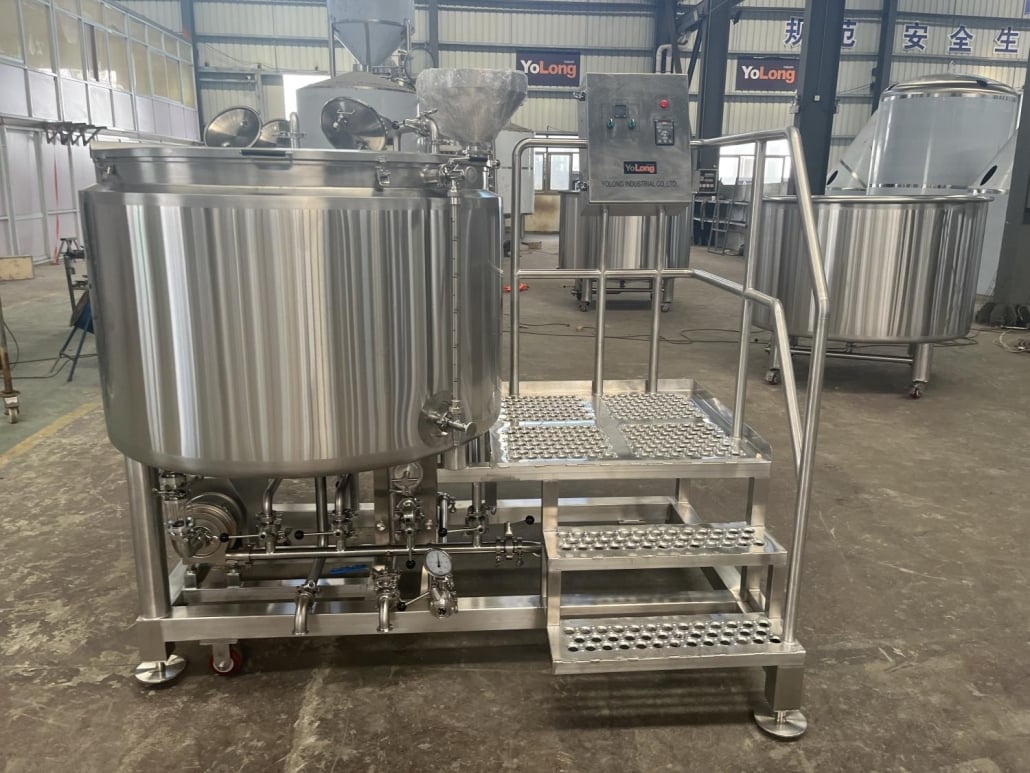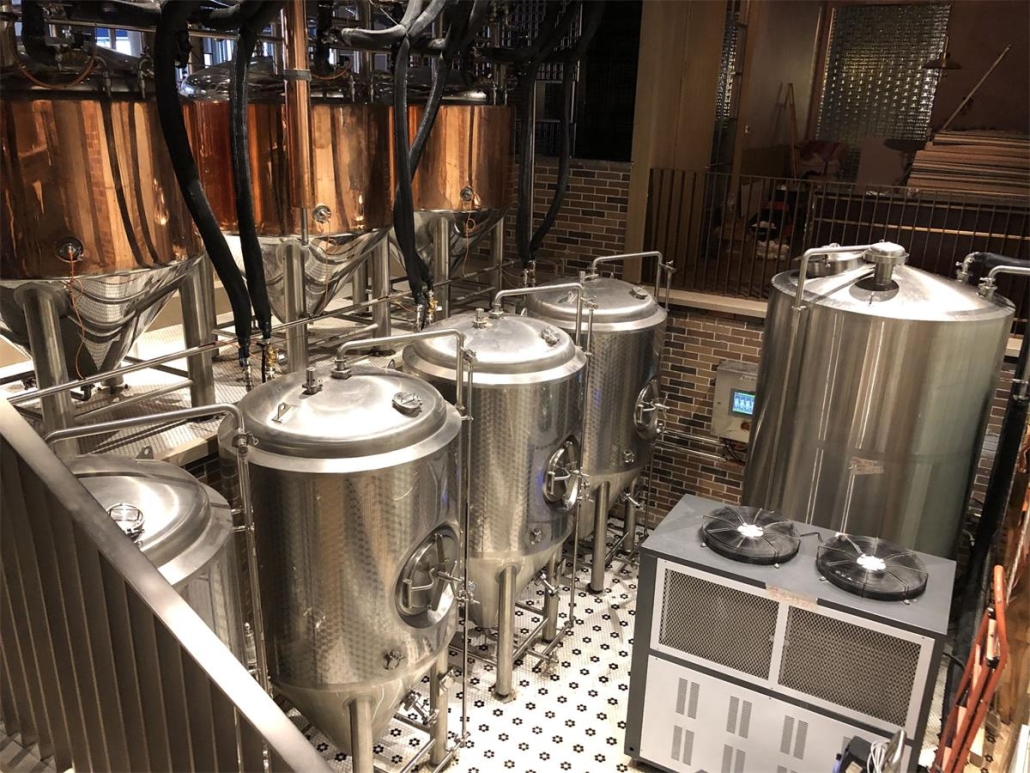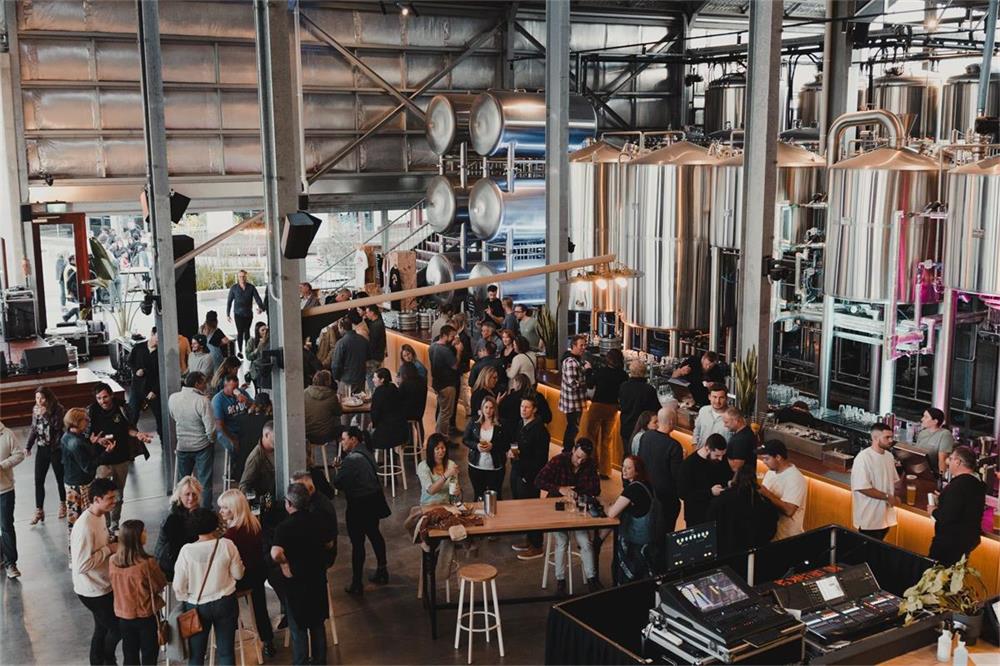5 BBL Brewhouse Systems
5 BBL Stackable Fermenters are a mid-sized commercial beer brewing system with a brewing capacity of around 155 gallons (588 liters) per batch. 5 BBL systems are popular with many small to mid-size craft breweries and brewpubs, as they allow for an economical jump in production capacity beyond tiny homebrewing-scale systems.
Key Specifications of Standard 5 BBL Stackable Fermenters:
| Brewing Volume | 5 Barrels, around 155 Gallons/ 588 Liters per batch |
|---|---|
| Mashtun Size | 200+ Gallon capacity |
| Kettle Size | 200+ Gallon capacity |
| Output | Estimated 180-220 Kegs per Week |
| Batch Time | 4-6 Hours Typical |
| Space Required | Around 1500 sq ft minimum |
| Operators Required | 1-2 Persons |

Types of 5 BBL Stackable Fermenters
5 BBL brewhouses are available in different configurations from various equipment manufacturers. Some key types include:
Table 1: Types of 5 BBL Brewhouse Equipment
| Type | Features |
|---|---|
| Standard Manual | Economical option with manual operation at each stage. Requires active staff management of each process step. |
| Automated | Fully auto, PLC-based operation with preset timers, valves, pumps for each brew stage. Allows 1-touch beer production with minimal staff. Pricier than manual units. |
| Semi-Auto | Mix of manual and automatic operation where key stages like wort boiling have motorized controllers but grain handling remains manual. Provides partial automation to cut staff while keeping cost lower than full automation. |
| Steam-Powered | Use steam boilers and coils instead of electric elements to heat water and wort. Especially useful when steam is available at the brewhouse location from other processes. Can be manual, semi-auto or auto config. |
| Multi-Vessel | Additional vessels beyond standard mashtun and kettle provided for specialty brewing, higher gravity batches etc. Vessels may include mash filter, cereal cooker, hop dosing tanks. |
| Pilot Scale | Compact brewhouse, manual operation oriented for new brewers or pilot batches, experimental brewing. Lower price and space requirement but lower automation and peak output than prod-focused options. |
5 BBL Brewhouse Standard Equipment Components:
Table 2: Components of a Standard 5 BBL Brewhouse System
| Component | Details & Purpose |
|---|---|
| Mash Tun | Insulated stainless steel vessel that holds milled grains for barley mash. Often direct steam-heated. Mixes mash for starch conversion to fermentable sugars. |
| Lauter Tun | Stainless container with false slotted bottom to separate sweet wort from grains after mash. Some systems combine mash and lauter tun into single unit. |
| Brewkettle | Boils wort after lautering, allowing flavors and aromas to develop. Usually direct steam or electric heated. Has all necessary plumbing fixtures. |
| Whirlpool | Swirl tank to separate trub and hop debris from clear wort after boiling. May be present as standalone tank or integrated whirlpool fittings in the brewkettle. |
| Heat Exchangers | Plate heat exchangers rapidly cool boiling wort to pitching temperature for yeast inoculation, preventing contamination and preservation of flavors. |
| Glycol System | External cooling system with glycol and water mix which circulates through jackets around brew kettle, fermenters etc. to control temperatures. |
| Piping | Food-grade stainless steel pipes, valves and pumps to transfer liquids between vessels and complete various brewhouse operations |
| Control Panel | Houses all electrical controls, switches, automation systems like PLC to enable brewhouse operation and monitoring. |
5 BBL Stackable Fermenters Design & Layout
Key design aspects for 5 BBL brewhouse layout:
- Linear alignment allows easy transfer of mash and worts from one vessel to next using gravity, with minimal pipes.
- Keeping taller vessels to edge of space minimizes headroom required
- Easy operator access doors provided for manual cleaning
- Control panel located close to kettle for monitoring critical boiling stage
- External cooling and chilling systems placed peripherally
- Compact footprint minimizes brewhouse floorspace needs
Brewhouse layout during building planning stage is crucial to optimize material flow, staff movement, and output capacity later during brewery operations.
Customization Options for 5 BBL Brewhouses
While standard turnkey 5 BBL systems are available, many breweries seek customizations and add-ons to tailor the system to their specific goals. Some options include:
- Upgraded kettles: Installation of multi-vessel arrangements with more boiling capacity
- Advanced Automation: Touchscreen HMI, IoT connectivity, automated CIP systems
- Ergonomic improvements: Platform lifts, catwalks and stairs for vessel access, customized fittings
- Grain handling systems: Integrated roller conveyors, augers and lifts for grain transfer and milling –Special process accessories: Flavor dosing tanks, wort oxygenation addons, quality monitoring systems
When planning add-ons, brewers should evaluate benefits versus added complexity in operations and higher capital costs. Step-wise expansion options help balance costs against immediate and future production goals.
5 BBL Stackable Fermenters Pricing and Supplier Landscape
Table 3: Typical Pricing for 5 BBL Brewhouse Systems
| Type | Price Range |
|---|---|
| Standard Manual | $80,000 to $120,000 |
| Semi-Auto | $140,000 to $180,000 |
| Fully Automated | $160,000+ |
| Pilot Scale | Under $60,000 |
| Used Systems | $50,000 to $100,000 |
In the US market, leading turnkey suppliers for 5BBL systems include:
| Supplier | Starting Price | ** Offerings** |
|---|---|---|
| Specific Mechanical | $105,000 | Custom fabrications, manual and auto |
| Portland Kettleworks | $96,500 | Quality kettles and vessels |
| Stout Tanks & Kettles | $99,000 | Broad catalogue, customizations |
| Premier Stainless | $125,000 | End-to-end fabrication, installation |
| AAA Metal Fabrication | $98,000 | Custom unitank buildouts |
| Pro Refrigeration | $140,000 | Integrated glycol chilling |
| Emerson Brewing | $75,000 | Modular pilot systems |
Pricing can vary based on level of automation, custom features, vendor reputation and relationships, associated installation and shipping costs, etc. Quoting from multiple vendors is recommended.
5 BBL Stackable Fermenters Operations
Table 4: 5 BBL Brewhouse Maintenance & Operation Guidelines
| Activity | Frequency | Purpose |
|---|---|---|
| Startup review | Daily | Verify lines & vessels are clean and ready for production |
| Water heating | As needed | Power up steam/electric energy to get strike water to temp |
| Grain dosing | Per batch | Transfer measured milled grains to mash tun |
| Sparge | 60-90 mins | Rinse grains to extract all fermentable wort over time |
| Wort boiling | 60-90 mins | Develop flavors and sanitize |
| Trub separation | Post-boil | Settle hops and coagulants via whirlpool |
| Heat exchange | After whirlpool | Rapidly cool clean wort before fermentation |
| Clean-in-place (CIP) | Weekly | Clean vessels and pipes using caustics |
| Preventive maintenance | Monthly | Inspect parts for wear & calibrate sensors |
| In-depth cleaning | Quarterly | Take vessels offline for deep interior scrubbing |
For reliable functioning, the brewhouse equipment must be carefully operated within supplier specifications and cleaned at regular frequencies. Production planning should account for periodic maintenance downtime.
Choosing the Right 5 BBL Stackable Fermenters Supplier
Table 5: Qualities to Evaluate in a Brewhouse Supplier
| Factor | Evaluation Criteria |
|---|---|
| Technical Expertise | Experience with systems at desired capacity and features; engineering quality and support standards |
| Equipment Quality & Range | Build quality, materials, warranty; range of integrated brewhouse equipment available |
| Custom Fabrication Skills | Ability to accommodate custom sizing, fittings, accessories, integrations |
| Customer Service | Responsiveness to inquiries and support calls; after-sales installation and troubleshooting services |
| Industry Reputation & Reviews | Talking to their existing customers to evaluate satisfaction levels and post-purchase support |
| Business Sustainability | Years in operation, financial health to be a long-term brewhouse partner |
Taking time to thoroughly evaluate technical strengths versus asking price allows brewers to find the “sweet spot” supplier offering the best long-term value.
Key Pros & Cons of 5 BBL Stackable Fermenters Scale
Table 6: Advantages and Disadvantages of 5 BBL Systems
| Pros | Cons |
|---|---|
| Allows substantially higher peak production than homebrew scale | Smaller output than large 20-30 BBL industrial systems |
| Flexibility for brewpub onsite draught needs and offsite distribution | Limitations on very high gravity (>8% ABV) brews |
| Lower capital investment than larger capacity brewhouses | Significant hands-on labor still needed for brewhouse operations versus fully automated systems |
| Supports a full range of craft beer styles and experimentation | Additional fermentation and storage capacity needs to be planned for peak output |
| Compact footprint fits smaller spaces than massive 30 BBL+ units | May still require upgrades in 3-5 years as brewery business grows |
For many startup and regional craft breweries aiming for intermediate capacity, 5 barrel systems hit a sweet spot in balancing production flexibility, output levels, investment budgets and space requirements.

Frequently Asked Questions
Q: What is the brewhouse capacity needed for packaging 5000 barrels of beer annually?
A: To package 5000 barrels (BBLs) per year, a brewhouse capacity of around 10-15 BBL is recommended, assuming 1-2 brews per day on average to account for fermentation, filtering, storage and packaging time. So a 10 BBL or 15 BBL system could support 5000 BBL annual packaged output.
Q: What size boiler system is needed to power a 5BBL brewhouse?
A: A good benchmark is a 20 bhp (boiler horsepower) steam boiler system for powering the mash tuns, brew kettles and other heating operations of a 5 BBL brewhouse. This provides sufficient steam pressure and flow rates to quickly heat water and wort while matching the brewhouse capacity.
Q: How much floor space should I budget for a new 5 BBL brewhouse and associated utilities?
A: Ideally plan for 1500 – 2500 square feet for the 5 BBL brewhouse system including boiler room, glycol tanks, fermentation tanks and packaging area. This allows comfortable space for operations, cleaning and maintenance access around all vessels.
Q: What is the difference between 2-vessel, 3-vessel and 4-vessel brewhouse configurations?
A: 2-vessel are the simplest, with just a combined mash/lauter tun and brewkettle. 3-vessel separates the mash tun and lauter tun for greater efficiency and flexibility. 4-vessel keeps these separate and adds a whirlpool tank for settling out trub post-boil prior to fermentation. Additional vessels can be added like hop back or water deaeration unit for further complexity in multi-vessel configurations.
Q: Should I choose fully automated or manual operation for 5BBL?
A: Automated operation can improve consistency and reduce direct labor requirements but costs more upfront. For maximum flexibility at start, many brewers recommend getting semi-automated equipment that only uses automation for critical boiling stage but keeps affordability for small scale. This also develops firsthand experience before adding more automation down the road.
Q: What are the options for financing new or used brewhouse equipment purchases?
A: Beyond self-funding, options like equipment leasing, SBA small business loans and craft brewery specific financing from companies like Encore Finance group allow spreading out the capital investment over longer terms. Used equipment bought from other breweries also reduces initial purchase costs but may incur higher lifetime maintenance charges.
Additional FAQs for 5 BBL Brewhouse Systems
1) What batch cadence makes a 5 BBL brewhouse viable for a busy taproom?
- Many brewpubs run 2–4 turns/week with 5 BBL brewhouse systems, supported by 2–4 x 10 BBL fermenters for double-batching. Aim for tank turns of 18–24 days on average to sustain variety and freshness.
2) Steam, direct fire, or electric for a 5 BBL kettle?
- Steam offers best control and scalability; direct fire is lower capex but needs proper combustion air/venting; electric is simplest to install but may require significant service amperage. Choose based on utilities, control needs, and local code.
3) How can I reduce water use on a 5 BBL system?
- Implement wort-water heat recovery to preheat brew liquor, optimize CIP with conductivity endpoints, and recapture final rinse for first-rinse next cycle. Water-to-beer ratios of 3.5–5.0:1 are achievable with tuning.
4) What simple QA investments pay off at this scale?
- A handheld DO meter, hydrometer/refractometer, pH meter, and a small sensory panel program. Target packaged DO ≤100 ppb (≤50 ppb for hop-forward beers); track brewhouse efficiency and pH through the mash/boil.
5) Can a 5 BBL brewhouse support limited distribution beyond the taproom?
- Yes. With double-batching and efficient cellar planning, 1,000–1,500 bbl/year is possible. Pair with a compact canning line or mobile canning, closed transfers, and cold-chain to maintain quality.
2025 Industry Trends: 5 BBL Brewhouse Systems
- Modular growth paths: Stackable unitanks and prefab utility skids reduce install time and enable stepwise expansion.
- Data-first brewing: Affordable PLC/HMI with batch logging, remote alarms, and OPC UA/MQTT connectivity reach the 5 BBL tier.
- Low-oxygen workflows: Closed transfers, O2‑tight gaskets, and inline/handheld DO checks become standard practice.
- Utility optimization: Heat recovery, jacket zoning, and tuned CIP programs cut water/energy 10–20%.
- Flexible packaging: More 5 BBL brewhouses pair with semi-auto canning (15–45 CPM) or mobile canning to test SKUs.
2025 Benchmarks for 5 BBL Brewhouse Systems
| Metric | Typical 2025 Value | Notes |
|---|---|---|
| Brewhouse efficiency | 70–85% | Depends on grist/lauter design |
| Water:beer ratio | 3.5–5.0:1 optimized | With heat recovery + CIP tuning |
| Glycol capacity (cellar) | 0.5–0.75 RT per active 5 BBL FV | +20–30% headroom for crash |
| Changeover (CIP) time | 45–90 min per vessel | Validated spray coverage helps |
| Packaged DO target | ≤100 ppb (≤50 ppb hazy/IPAs) | Closed transfers required |
| Install timeline | 2–6 weeks on-site | After utilities and FAT |
| New system price | $80k–$180k | Spec/automation dependent |
Sources: Brewers Association benchmarking 2024–2025; MBAA Technical Quarterly; ASBC methods; OEM spec sheets; ProBrewer practitioner reports
Latest Research Cases
Case Study 1: Heat Recovery + CIP Optimization on a 5 BBL System (2025)
Background: Brewpub reported high water-to-beer ratio (~6.1:1) and long turnarounds.
Solution: Implemented wort-water heat recovery loop, standardized CIP with conductivity-based phase endpoints, verified spray coverage, and added insulation to hot liquor lines.
Results: Water-to-beer reduced to 4.0:1; CIP time −20 minutes per vessel; gas usage −9%; annual utility savings projected at 11%.
Case Study 2: Low-Oxygen Packaging SOPs Extend Shelf Life (2024)
Background: 5 BBL operation saw hop aroma fade by day 60 in cans.
Solution: Introduced CO2 purges of lines/vessels, foam-on-beer for seaming, upgraded O2‑tight elastomers, and handheld DO checks each run with seam teardown validation.
Results: Packaged DO 35–85 ppb; returns for staling −26%; sensory shelf life extended beyond 90 days under cold-chain.
Expert Opinions
- Dr. Tom Shellhammer, Professor of Fermentation Science, Oregon State University
“Even at 5 BBL scale, oxygen control and thermal consistency are decisive for flavor stability and foam performance.” - Mary Pellettieri, Quality Consultant; author of Quality Management for Breweries
“Documented SOPs for cleaning, transfers, and packaging deliver repeatability—your best defense against variability on small systems.” - John Mallet, Brewing Operations Consultant; author of Malt: A Practical Guide
“Design for daily work: drainability, cleanability, safe access, and reliable utilities trump headline automation features in small brewhouses.”
Practical Tools and Resources
- Brewers Association – Small brewery start-up and QA resources: https://www.brewersassociation.org
- Master Brewers Association of the Americas (MBAA) – Technical papers on brewhouse/cellar design, CIP: https://www.mbaa.com
- American Society of Brewing Chemists (ASBC) – Analytical methods (DO, CO2, pH, VDK): https://www.asbcnet.org
- ProBrewer – Forums on 5 BBL layouts, utilities, and vendors: https://www.probrewer.com
- OSHA/NIOSH – Brewery safety for steam, CO2, ergonomics: https://www.osha.gov and https://www.cdc.gov/niosh
- OEM resources – FAT/SAT checklists and utility matrices from equipment suppliers
Sources and further reading:
- BA 2024–2025 benchmarking on water/energy and small-brewery KPIs
- MBAA Technical Quarterly on heat recovery, jacket zoning, and oxygen management
- ASBC methods for QA scaling to small systems
- Practitioner threads on ProBrewer about 5 BBL efficiency, CIP, and packaging SOPs
Last updated: 2025-09-08
Changelog: Added 5 targeted FAQs; created a 2025 benchmarks table; provided two case studies on utility optimization and low-oxygen packaging; included expert viewpoints; compiled practical tools/resources with authoritative links.
Next review date & triggers: 2026-01-15 or earlier if BA/MBAA/ASBC guidance updates, new OEM tech impacts 5 BBL specs, or benchmarking shifts in water/energy/DO targets emerge.
Share this entry
Interested in learning more about Brewing Systems including additional details and pricing information? Please use the form below to contact us!
YOLONG BREWERY EQUIPMENT FAQS
- Commercial Brewery / Craft Brewery / Microbrewery / Nanobrewery
- What is The Difference Between Craft Beer and Industrial Beer?
- The Bespoke Differences In Custom Brewing Systems
- Everything You Need to Know About Kettle Souring
- How to Choose Brewing Equipment for Your business?
- How To Choose The-Best Partner To Build Your Commercial Microbrewing System?
- Two Detection Sensors That You Need To Use In Your Brewhouse System
- Remote Control Applications in Brewing Equipment/How does it work?
- How To Clean Your Brand New Brewery Tanks?

